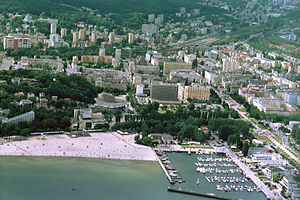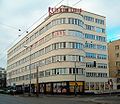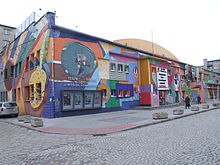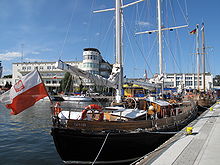Gdynia
![]()
The title of this article is ambiguous. For the ship of the same name, see Gdynia (ship, 1927).
Gdynia [ˈgdɨɲa] (Kashubian Gdiniô), German Gdingen, 1939-1945 Gotenhafen, is a port city in Poland in the Bay of Gdansk. It forms the Tri-City Metropolitan Region in the Pomeranian Voivodeship with the largest city Gdansk (Gdańsk) and the smaller Sopot (Sopot).
First documented as the settlement of Gdina in 1253, Gdynia was granted city status in 1926. The most important port city of the Second Polish Republic became a major city in the 1930s with over 100,000 inhabitants. During the Second World War, Gdynia, which was called Gotenhafen during this time, was considerably destroyed by British and US air raids as an important base of the German navy.
Today, Gdynia ranks twelfth among Poland's largest cities, with a population of around 250,000. Gdynia is the headquarters of the Navy of the Republic of Poland and has two nautical colleges, the Naval Academy Akademia Marynarki Wojennej and the civilian Akademia Morska.
Geography
Location
Gdynia is located in northern Poland on the Zatoka Pucka (German: Putziger Wiek; Kashubian: Pùckô Hôwinga), which forms the western, shallow part of Gdansk Bay. Opposite Gdynia is the Hel Peninsula (Polish: Półwysep Helski, Mierzeja Helska) with the town of Hel, which can be reached by ferry from Gdynia in the summer months.
The largest watercourse in the city is the Kacza, which passes through the districts of Dąbrowa, Mały Kack and Orłowo. The city lies just above sea level in the port and inner city areas, while the outer districts, including Witomino, Mały Kack and Wielki Kack lie on the landward, rising heights.
City breakdown

| Polish name | Kashubian name | German name (until 1920 and 1939-1945) |
| Babie Doły | Coven Ground | |
| Chwarzno | Chwôrzno | Quarszau (1874-1945 Völtzendorf) |
| Chylonia | Chëlonô | Kielau |
| Cisowa | Cësowô | Ciessau (1942-1945 Zissau) |
| Dąbrowa | Dohnasberg | |
| Demptovo | Demptowò | Demptau (1942-1945 Demtau) |
| Działki Leśne | Lasné Dzélczi | |
| Grabówek | Grabòwka | Grabau |
| Kamienna Góra | Kamiannô Góra | Steinberg |
| Karviny | Karwinë | |
| Leszczynki | Laszinken (1942-1945 Sandnußdorf) | |
| Mały Kack | Małë Kack | Little Katz (1942-1945 Kleinkatz) |
| Obłuże | Òblëżé | Oblush |
| Oksywie | Òksëwiô | Oxhöft |
| Orłowo | Òrzłowò | Eagle Nest |
| Pogórze | Pògòrzé | Pogorsch (1942-1945 Gotenberg) |
| Pustki Cisowskie | Cësowsczé Pùstkòwié | Pustkowie (1942-1945 Zissauerwald) |
| Redłowo | Wësoké Redłowò | Highredlau |
| Śródmieście | Strzódgard | City Centre |
| Wiczlino | Wiczlëno | Wiczlin (1874-1945 Vitzlin) |
| Wielki poop | Wiôlgë Kack | Groß Katz (1942-1945 Großkatz) |
| Witomino | Witòmino | Wittomin |
| Wzgórze Św. Maksymiliana | Sw. Jan | Johanniskrug (1940-1945 Baltenberg) |
Culture
Architecture
· 
House of the Stankiewicz family
· 
Construction of the ZUS, now POL
· 
The market hall
· 
The court at Plac Konstytucji
· 
Corner house of the Orłowski family
· 
Skwer Kościuszki 2005 at the commemoration of the beginning of the Second World War
In 1928, the Port Construction Office was built with a small courtyard in the style of historical Polish mansions. From 1928 to 1937, the Pręczkowski family had one of the first burgher houses in Gdynia built in modernist style at Skwer Kościuszki 10-12 on the corner of ulica Żeromskiego.
The architect Tadeusz Jędrzejewski created rounded facade walls and a turret, which quote shapes of a command bridge and round ship's sides. On the ground floor, before and for many years after the war, was the Polonia Cinema, later renamed Goplana. In 1929 Stanisław Filasiewicz built a building in the historicist style for Bank Polski at ulica 10 Lutego 20/22 (Street of February 10, 1926) with a magnificent interior, including the banking hall under a column-supported vault. In 1930 Jerzy Müller built the Government Commissariat for the Second Polish Republic at 52/54 Aleja Piłsudskiego, which was extended in 1937 with a wing on Bema Street.
Tadeusz Jędrzejewski and Włodzimierz Prochaska built a residential and commercial building for the Stankiewicz family at ulica Świętojańska 53 in 1931. In the gateway of the house, the current owners have set up a small exhibition on the history of the house. In the same year, an old-school villa was built in Kielau (pl. Chylonia, kasch. Chëlonô) and the Weneda villa and the Gryf boarding house were built in Adlershorst.
Between 1932 and 1935, the architect Marian Maśliński created a corner house for Juliusz von Hundsdorff at ulica Starowiejska 7.
At ulica 10 Lutego 24, an office building for the Polish Social Insurance Fund (Zakład Ubezpieczeń Społecznych, ZUS) was built in 1935/1936 to a design by Roman Piotrowski. It is one of the symbols of modernism of the interwar period with structures of different sizes as well as an exposed rounded part. The facades are covered with black granite at the bottom and light sandstone at the top. Today, the building houses the Polskie Linie Oceaniczne (Polish Ocean Lines, POL) shipping company.
The Gospodarstwa Krajowego Bank commissioned Stanisław Ziołowski to build the largest residential building in Gdynia in the pre-war period at the corner of ulica 3 Maja 27/31 and ulica Batorego 26 (Stephan Bathory Street). The semi-circular tower on ulica 3 Maja (3 May 1791 Street) is a striking feature. The building was equipped with modern facilities, including an underground car park. The facades are decorated with limestone from Szydłowiec in the Carpathian foothills. In ulica Wójta Radtkego (Mayor Radtke Street), Stefan Reychman and Jerzy Müller created the Market Hall, a three-part arched structure, from 1935 to 1938.
As part of the city expansion plans of the architect Stanisław Filipowski, the 600 m long and 120 m wide representative southern pier was built in 1935 to 1937 as an extension of the axis of ulica 10 Lutega in place of the old wooden pier. At the end of the pier, a 10-metre-high obelisk was to commemorate the unification of the three-divided Poland into the Second Republic between 1918 and 1921. This never happened, today there is a statue of the writer Joseph Conrad Korzeniowski, created by Zdzisław Koseda. On the southern pier, the Aquarium was built from 1937 - interrupted by the Second World War - and opened in 1971.
As another representative building in this good room of Gdden, Bohdan Damięcki and Tadeusz Sieczkowski erected the House of the Polish Sailor in 1938/1939. A round protruding part defines the facade facing the Sailor's Basin (Basen Żeglarski). Today it houses the Navigational School of the Westerplatte Heroes Naval Academy and a planetarium. Furthermore, the museum ships ORP Błyskawica and Dar Pomorza mentioned above are moored on the southern pier. Stanisław Płoski built the House of Swedish Seamen at ulica Jana z Kolna 25 in 1936, which housed a hotel and a Swedish consulate.
At Plac Konstytucji 5, a functionalist building for the District Court and the Prosecutor's Office was built in 1936. The Orłowski family had a modernist corner building built at ulica Świętojańska 68 in 1936, consisting of a six-storey structure with rounded corners and windows and a seven-storey cuboid building. The facades are faced with light sandstone. Until 1939, the lower floors housed a branch of the French department store chain Le Bon Marché. Today it houses a book and press salon.
In the same year, also in ulica Świętojańska 122 at the corner of Aleja Piłsudskiego, the architect Leon Mazalon created for himself and the lawyer Antoni Ogończyk-Bloch a corner house with interesting emphasis of the corner location by vertically superimposed streamlined winter gardens and similar balconies facing Aleja Piłsudskiego. Opposite the main railway station, also in 1936, a monumental building was built according to designs by Zbigniew Karpiński (Polish), T. Sieczkowski and R. Sołtyński. The avant-garde building consists of a main ashlar containing the entrances and the tall main hall, two symmetrical curved wings, and a rectilinear wing facing ulica Jana z Kolna. At Skwer Kościuszki 16, Zbigniew Kupiec and Tadeusz Kossak built a modern burgher house for the Jurkowski family in 1937/38, of reinforced concrete skeleton construction with a façade faced with yellow ceramic tiles. Greenery was provided for. A park was created on the Steinberg and the Hochredlauer Kämpe (Kępa Redłowska) with its forests and cliffs was declared a nature park in 1938 with 110 ha. A 1½-kilometre-long Baltic Sea promenade, Feliks Nowiejski Boulevard, connects Hochredlauer Kämpe with the town. In 1939 Kupiec and Kossak created a corner house for the Krenski family at ulica Świętojańska 55 corner of ulica Żwirki i Wigury with a high corner building and lower side wings facing the neighbouring houses. Due to the beginning of the war, the building remained unplastered, the ground floor without finishing and the imported elevator in the port.
Museums
- Museum Abraham House (ul. Starowiejska 30)
- Motor Museum (ulica Żwirowa 2C)
- Museum of Kashubian Tales (ul. Zwycięstwa 36/108)
- Museum of the City of Gdynia (ul. Zawiszy Charnego 1)
- Żeromski House (ul. Orłowska 6)
- Antoni Ledóchowski Planetarium (aleja Jana Pawła II, entrance from the marina)
- Emigration Museum Gdynia
Maritime museums
- Aquarium Gdynia (aleja Jana Pawła II 1)
- Museum ship ORP Błyskawica (aleja Jana Pawła II, Nabrzeże Pomorskie/Pomerania quay)
- Museum ship Dar Pomorza (aleja Jana Pawła II, Nabrzeże Pomorskie/Pomerania quay)
- Open-Air Museum of Deep-Sea Fishing (ul. Orłowska 6)
- Museum of the Navy (ul. Sędzickiego 3)
- Museum of Pomeranian Maritime Crafts (ul. Waszingtona 21, in the Gemini Cultural and Entertainment Centre)
Theatre
- Danuta Baduszkowa Music Theatre (płac Grunwaldzki 1)
- Witold Gombrowicz Theatre (ul. Bema 26)
- Summer theatre on the beach stage in the district of Orłowo
- Teatr Gdynia Główna (Plac Konstytucji)
Music
- Annual music festival Open'er Festival on the airfield

Witold Gombrowicz Theatre

Ships at the Gdynia marina with a view of the planetarium
Search within the encyclopedia